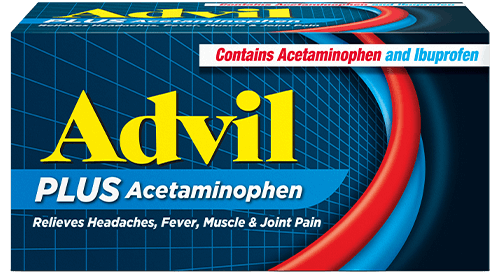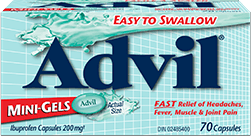What Are “Menstrual Cramps”, and What Causes Them?
Don’t let menstrual pain get in the way of your daily activities.
Menstrual cramps are lower abdominal pain that starts during menstrual bleeding and slowly gets better over the next 12-72 hours. Pain from menstrual cramps is primarily caused by an increase in certain types of pain producing chemicals, and can be relieved with over-the-counter (OTC) pain medicines like Advil® Liqui-Gels®.1 Period cramps occur in many women, however, unlike any ordinary pain, it can get in the way of your daily activities and affect your quality of life.2
What causes menstrual cramps?
To better understand menstrual cramp pain, let’s go through the step-by-step process of what causes cramps:
It Starts with More Pain Producing Chemicals in your Body
- During your regular menstrual cycle, the levels of many natural chemicals in your body, like prostaglandins, increase. Prostaglandins are the ones that cause the pain, and they can rise to as high as 6 times their normal level!3 Now that we know prostaglandins are the cause, let’s learn what they do.
Less Blood Flow
- Normally, prostaglandins cause your blood vessels to shrink and cause your uterus to contract. Higher levels of these chemicals at that moment mean those effects can be stronger.4
Sensitive Nerves
- Your nerves detect pain throughout your body and there are a lot of nerves naturally in the uterus. Increased levels of prostaglandins cause those normal nerves to become more sensitive. Then when you experience pain, those now-sensitive nerves cause you to feel more pain than you usually would.4
More Activity
- Generally during your period, the uterus is more active to prepare for childbirth. That natural activity and movement can add to the pain you experience.4
Less Oxygen
- We already know that prostaglandins cause your blood vessels to shrink. Shrinking blood vessels carry less oxygen rich blood, which means you have less oxygen getting to your uterus. With less oxygen to fuel them, your muscles get tired, especially when they are so active. The contraction of those tired muscles can be painful.4
Why does the severity of menstrual cramps vary from person to person?
Pain during menstrual cramping is common. But everyone’s body is unique! Most women have pain of different intensities during their period, some with mild to moderate pain and others with more severe menstrual cramps. It is not exactly clear why contractions are painful in some women but not others, but it could be because of differences in hormone levels and how uniquely sensitive each person is to those hormones.5 But what we do know is that if primary menstrual pain happens, it’s caused by prostaglandins.
How can Nonsteroidal Anti-Inflammatory Drugs (NSAIDs) relieve period cramps?
Now that we know that prostaglandins are the main cause of primary menstrual pain, there are options that can provide powerful and effective relief.
There are many OTC medications available for the relief of period pain, including acetaminophen and ibuprofen. Unlike acetaminophen, which blocks pain signals to your brain, ibuprofen targets pain at the source. For fast, effective relief of period pain, you can use Advil® Liqui-Gels®, or Advil® Extra Strength Liqui-Gels®.
For more information about periods and menstrual pain, visit the menstrual pain section of our website.
*Among other single ingredient OTC pain relievers.
Sources:
- Hall JE. Menstrual Disorders and Pelvic Pain. In: Kasper D, Fauci A, Hauser S, Longo D, Jameson J, Loscalzo J. eds. Harrison's Principles of Internal Medicine, 19e. New York, NY: McGraw-Hill; 2015. http://accessmedicine.mhmedical.com/content.aspx?bookid=1130&Sectionid=7.... Accessed October 16, 2016.
- Harada T. Dysmenorrhea and Endometriosis in Young Women. Yonago Acta Medica. 2013;56(4):81-84.
- Dawood, M. Y. "Primary Dysmenorrhea-Pathophysiology and Management." Journal of the Islamic Medical Association of North America 13.4 (1981).
- Lacovides, S. et al. "What we know about primary dysmenorrhea today: a critical review." Human reproduction update (2015).
- Period pain: Overview. PubMed Health. U.S. National Library of Medicine. 2016. https://www.ncbi.nlm.nih.gov/pubmedhealth/PMH0072508/. Accessed October 17, 2016.
- Dawood, M. Y. "Dysmenorrhoea and prostaglandins: pharmacological and therapeutic considerations." Drugs 22.1 (1981): 42-56.
- Data on File.
Be sure this product is right for you. Always read and follow the directions on the label. This information is provided for educational purposes only and should not be used as a substitute for professional medical advice, diagnosis, or treatment. Speak to your healthcare professional before making any changes to your lifestyle or before beginning or discontinuing any course of treatment. Never disregard professional medical advice or delay in seeking it because of something you have read on this site.






